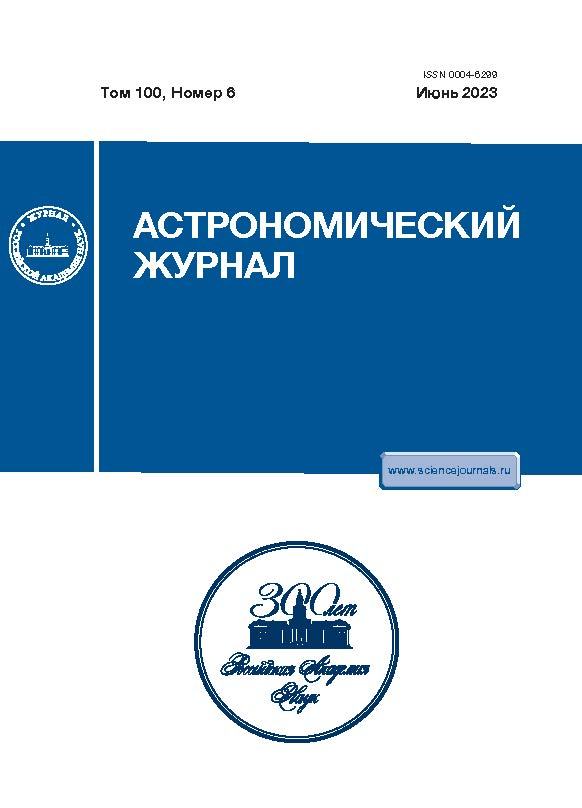The Catalog of Resolved Spectroscopic Binaries: Development and Description
- Authors: Zeleke D.B.1,2, Pakhomova P.V.3, Tessema S.B.1, Negu S.K.1, Malkov O.Y.3
-
Affiliations:
- Space Science and Geospatial institute, Entoto Observatory and Research Center
- Addis Ababa University
- Institute of Astronomy, Russian Academy of Sciences
- Issue: Vol 100, No 6 (2023)
- Pages: 512-516
- Section: Articles
- URL: https://journals.rcsi.science/0004-6299/article/view/139090
- DOI: https://doi.org/10.31857/S0004629923050110
- EDN: https://elibrary.ru/YXGAUT
- ID: 139090
Cite item
Abstract
Resolved spectroscopic binaries are unique among other types of binaries. They provide the only possibility (aside from trigonometric parallaxes) to accurately determine distances to objects, which is one of the most important characteristics in astronomy. Such binaries are not numerous, but an exhaustive catalog of them still does not exist. The authors have developed a pilot version of a new catalog of resolved spectroscopic binaries. It contains information about orbital elements, component masses, parallaxes, and other parameters for 107 stars. Thus, the catalog represents the most extensive list of resolved spectroscopic binaries known to date. A preliminary analysis of the distributions of the stellar parameters of the objects in the catalog has been carried out, as well as a comparison of the trigonometric parallaxes from Gaia DR3 with the orbital parallaxes. The article is partly based on a report presented at the conference “Modern Stellar Astronomy-2022,” which was held at the Caucasian Mountain Observatory of the Astronomical institute of Lomonosov Moscow State University on November 8–10, 2022.
Keywords
About the authors
D. B. Zeleke
Space Science and Geospatial institute, Entoto Observatory and Research Center; Addis Ababa University
Email: malkov@inasan.ru
Addis Ababa, Ethiopia; Addis Ababa, Ethiopia
P. V. Pakhomova
Institute of Astronomy, Russian Academy of Sciences
Email: malkov@inasan.ru
Moscow, Russia
S. B. Tessema
Space Science and Geospatial institute, Entoto Observatory and Research Center
Email: malkov@inasan.ru
Addis Ababa, Ethiopia
S. Kh. Negu
Space Science and Geospatial institute, Entoto Observatory and Research Center
Email: malkov@inasan.ru
Addis Ababa, Ethiopia
O. Yu. Malkov
Institute of Astronomy, Russian Academy of Sciences
Author for correspondence.
Email: malkov@inasan.ru
Moscow, Russia
References
- D. Pourbaix, Astron. and Astrophys. Suppl. Ser. 145, 215 (2000).
- L. Piccotti, J. Á. Docobo, R. Carini, V. S. Tamazian, E. Bro-cato, M. Andrade, and P. P. Campo, Monthly Not. Roy. Astron. Soc. 492, 2709 (2020).
- A. Gallenne, G. Pietrzyński, D. Graczyk, B. Pilecki, et al., Astron. and Astrophys. 632, id. A31 (2019), a-rXiv:1910.03393 [astro-ph.SR].
- J. B. Le Bouquin, H. Sana, E. Gosset, M. De Becker, et al., Astron. and Astrophys. 601, id. A34 (2017), ar-Xiv:1608.03525 [astro-ph.SR].
- J. L. Halbwachs, H. M. J. Boffin, J. B. Le Bouquin, F. Kiefer, et al., Monthly Not. Roy. Astron. Soc. 455, 3303 (2016), arXiv:1510.07412 [astro-ph.SR].
- F. Kiefer, J. L. Halbwachs, Y. Lebreton, C. Soubiran, et al., Monthly Not. Roy. Astron. Soc. 474, 731 (2018), arXiv:1710.09604 [astro-ph.SR].
- Gaia Collaboration, VizieR Online Data Catalog: I/355 (2022).
Supplementary files












